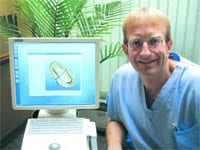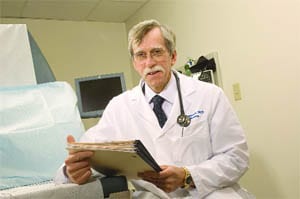Milling and Able CEREC Technology Gives Patients Dental Crowns in One Visit
No one enjoys going to the dentist, and the fewer trips, the better.
Well, cutting-edge (chewing-edge?) computer technology known as CEREC is allowing patients of Dr. David Peck to spend less time in the chair and more time simply enjoying their repaired teeth.
“CEREC is a computer-aided technology,” said Peck, who practices in downtown Springfield. “What it does is, it takes an optical image of a tooth, versus an impression of a tooth that a dentist might take.”
Consider how a crown is traditionally made. It’s a two-part process: on the first visit, the tooth is prepared by being shaved down somewhat, and the dentist takes an impression of the teeth, which is sent to a laboratory where the crown will be formed.
In the meantime, the patient wears a temporary crown made of some type of plastic material. On the patient’s second appointment, typically a few weeks later, the temporary crown is removed, and the permanent crown is placed on the teeth.
That was in the days before CAD-CAM technology, however. That acronym stands for ‘computer-assisted design, computer-assisted manufacture,’ and it has saved patients plenty of time, discomfort, and inconvenience in receiving needed dental work, said Peck.
One-stop Chopping
Essentially, CEREC eliminates the laboratory step from the equation. Instead, the dentist prepares the tooth being restored by treating it with a white powder or spray and imaging it with a 3D camera. That image is uploaded to the CEREC computer.
From there, the imaged information is sent to a milling machine, where the crown is milled out of a solid block of porcelain in less than 10 minutes. The crown is then placed into the patient’s mouth, and … well, that’s it.
“With an impression, you have to wear a temporary crown for two to four weeks, then come back for a second appointment, with more time out of your day, and a second injection of anesthesia,” said Peck. “Now, we can mill a crown in four to six minutes, polish it up, and bond it during the same visit.
“It’s one-visit dentistry that honors the time of a busy housewife or a busy businessperson,” he continued. “You don’t have to walk around with a temporary that can come loose. And it looks great on the tooth.”
The CEREC technology was first developed at the University of Zurich in Switzerland in the early 1980s, and the first patient was treated in 1985. But only in the past decade has it become widely available in the U.S. As of last year, some 23,000 dental professionals had used CEREC worldwide.
According to various dental sources, in addition to the time and convenience factor, the CEREC process has other advantages, including the ability to adapt the technology to fillings; the porcelain material has proven to be more durable than typical white composite fillings. And although the initial investment in CEREC is expensive for a dentist, it can save money over the long run because only one appointment is required, and there is no additional lab technician fee.
At the same time, because the crowns are milled from a single block of ceramic, it can be difficult to incorporate the subtle color gradients of natural teeth, particularly on front teeth. And using the CEREC system requires extra training on the part of the dentist. But Peck said Australia-based Sirona, which owns the CEREC process, has strived to met dentists halfway.
“The technology has been around for years, but recently they have improved the software so that you don’t have to be some kind of Photoshop genius to do the work,” Peck told The Healthcare News. “You do have to be somewhat computer-savvy to design the crowns, but the software is much more user-friendly than it was in the past.”
Many Smiles to Go
In 24 years practicing in Springfield, performing both general dentistry and restorative work, Peck has seen plenty of changes in the way patients are treated. The biggest change, he said, has been the move away from silver fillings and toward porcelain materials that are more compatible with people’s mouths, not to mention more natural-looking.
That has corresponded to an industry-wide shift away from silver amalgam fillings, which typically contain low levels of mercury, to adhesive dentistry, which bonds various cement-like materials more organically to the tooth surface. “That has been a huge change,” he said.
Peck added that CEREC makes sense for his practice in that he always strives for a family-friendly, comfortable environment, with amenities like warm blankets and video eye screens so patients can watch movies during procedures — “anything to take the fear away and make people feel more comfortable,” he said.
CEREC, he said, reduces anxiety simply by reducing the amount of time patients have to spend in the chair.
“People just love it,” Peck said. “They love being able to come in for just one visit. The appointment is longer because we’re doing everything in one visit, but the patients leave happy with a smile on their face.”
Quite a natural smile, too, for something created on a computer.




